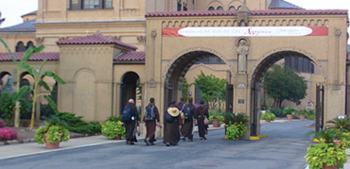Trust God and hit the road
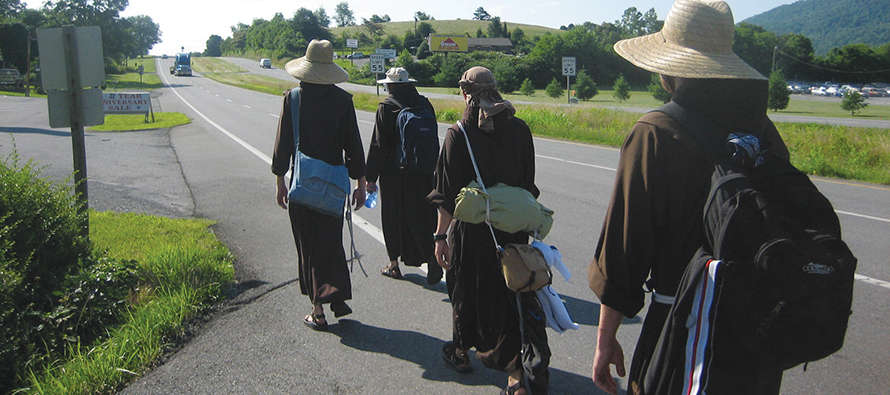
Image: THE OFTEN lonesome road forced the friars to rely on God and each other.
PILGRIMAGE is about conversion. One leaves the safety, security, and comforts of home and life in order to be changed. There is nothing wrong with everyday life, but we need to be challenged; we need to grow. This was precisely why we six friar brothers decided to walk 300 miles through Virginia.
We wanted to experience the purity of a mendicant (begging) life, which our founder, Saint Francis of Assisi, established 800 years ago. Francis was a man who embraced poverty as a noble lady; a man who walked with no worry, blindly trusting that the well of the Lord’s generosity would never run dry; a man who simply loved, because he was loved by God.
That was what we wanted, all six of us: to be poor, trusting, loving brothers. So in the summer of 2009 we began a six-week pilgrimage of trusting in the Lord through the generosity of his people. We wanted to carry little in order to allow our arms to embrace the Lord’s trust. We did—but it wasn’t easy.
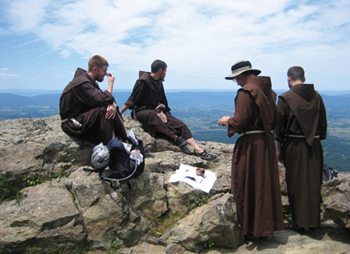 |
| THE FRIARS prepare to celebrate the Eucharist along the Appalachian Trail. |
People are good
Of the six walking friars—Richard Goodin, Mark Soehner, Clifford Hennings, Ed Shea, Joshua van Cleef, and myself, Roger Lopez—four were aged 30 and younger. We began our trip on June 21, 2009 in Salem, Virginia, a few days after three of us had taken our first vows as Franciscans.
When Jesus sent the apostles out on mission, he told them “to take nothing for their journey except a staff; no bread, no bag, no money in their belts” (Mark 6:8). We did much the same. We carried no money. We used no vehicle. We had a map, but no directions. We took only a simple shoulder bag packed with a water bottle, a book of the hours (daily prayers), and a blanket.
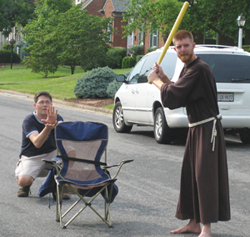 |
| BROTHER Richard Goodin, O.F.M. joins a game of Wiffle ball in Harrisonburg, Virginia. |
That meant every day presented the question of what to eat and where to sleep. Walking along the shoulder of a multilane highway with cars flying by at approximately 70 miles per hour, hard enough to blow the straw hat off your head, is but one distraction in a day of pilgrimage. What are we to eat today? Will we sleep in a bed tonight or outside on picnic tables, like other nights? Are we lost? Do these ticks have Lyme disease?
Despite the uncertainty, we never went a day without food, without some nutrients—though that might take the form of only a couple of energy bars. Toward the end of the second day, we were “hot, tired, hungry, had no place to stay,” to quote Father Ed. Around 7 p.m. we started knocking on doors, giving our standard introduction: “Hello! We are Christian pilgrims.” A yard sign at one house looked promising: “Happy Birthday, Jesus,” it read, and the man who lived there said to us: “My faith tells me to give you what you need and send you on your way.” He gave us $19, enough for a loaf of bread, two jars of peanut butter, two bags of potato chips, and Little Debbie snack cakes. “It was,” Mark says, “the best meal.”
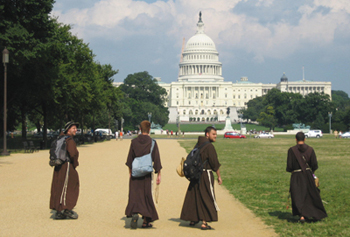 |
| THEIR JOURNEY almost complete, the friars make it to the nation’s capitol. |
Later in the trip the owners of a vineyard gave us cheese, baguettes, chocolates, and three bottles of wine for the road. A passing motorist bought us lunch. Another person sprung for a steak dinner at a local restaurant.
“Accommodations” took the form of whatever we could find—or not. We slept in wood-and-stone shelters on the Appalachian Trail; the floor of a Baptist church; a trampoline next to a firehouse (when one friar moved, we all moved); and picnic tables behind a church. We spent a night in the home of a tattooed and toothless Native American healer (with whom we exchanged gospel and Native stories as well as double-flute playing and Latin hymn chanting). A Trappistine abbey, a number of Catholic churches, a church deacon’s basement, a police academy barracks, and several homes of strangers also provided shelter.
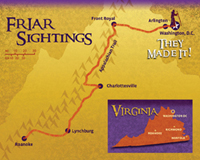 |
| THE FRIARS’ route. |
“God never stopped surprising us with the goodness of people,” Josh says. When we got lost in Shenandoah National Park, we received—in the space of an hour and a half—directions from a Mennonite fisherman, water and granola bars from a Catholic woman, a ride down the mountain from a Jewish man, and lodging for the night from a Hindu family. “I think that may be God’s greatest gift to us,” Richard says. “We told every single person we stayed with, ‘You are a part of the big journey.’ To me, we have been instruments in people’s lives, and they’re the vehicle that got us here.”
“There’s little reservation left in my heart that people are good,” Richard says, “and God is humongous.”
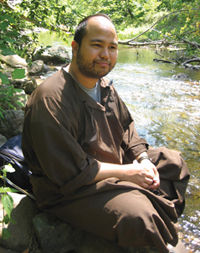 |
| BROTHER Roger Anthony Lopez, O.F.M. takes a rest on the journey. |
Take no money
When we had the opportunity we would work in return for hospitality: weeding flower beds, mowing lawns, painting sheds and picnic tables, transplanting trees, moving furniture, fixing lights and toilets, and organizing rooms full of junk.
We had taken no money with us and had not planned to accept any. If people said, “Do you need money?” we told them no. But at a going-away party for the pastor of a Salem, Virginia parish, people kept slipping us money—a little over $400. That’s when we decided, “OK, we’ll take it—but we’ll give away what we don’t spend in one day.” We gave most to a poor parish in Roanoke; with the rest we had a nice meal at Jersey Lily’s and tipped the waitress $70!
A sight to behold
Needless to say we attracted attention. Some thought we were Jedis on our way to a Star Wars convention. Others took us for Shaolin monks. Or Ninjas. Or Amish. At the Lincoln Memorial folks wanted their picture taken with us. By the time we got to Harrisonburg, Virginia, we had already been featured in four newspapers and photographed hundreds of times by motorists. “Francis has this universal appeal,” Ed says. “We entered into that.”
Our 10-to-15-miles-a-day pace gave us time to talk with people. They would come to talk to us about “the sacred,” whatever that was to them. We became “ears” for people to tell their stories to. A lot of people wanted to talk about the struggles in their lives. Others said God was working so generously in their lives they wanted to share.
Dressed as we were in our habits, it was like a walking sign that said, “Tell us your life’s problems.” And people did. They poured out their hearts.
Along the Lee Highway in Fairfax, Virginia, as we neared the end of our journey, Mary Williams, who was running errands with her three children, picked us up in her minivan and took us out to eat at a Chick-fil-A.
Williams had grown up on the other side of the woods behind St. Leonard’s, the Franciscans’ school of theology in Centerville, Ohio; her father’s business partner is a friend of Brother Richard’s parents; and she attended the same high school in Ohio Father Mark was from.
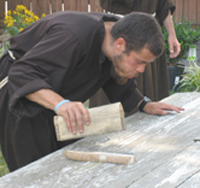 |
| BROTHER Joshua van Cleef, O.F.M. sands a picnic table for Our Lady Queen of Peace Parish in Arlington, Virginia in return for the hospitality it offered. |
“It was the oddest experience sitting there at Chick-fil-A with everyone staring at us,” Williams says. “The high point was when the guy dressed up like a cow came out and gave us all high fives. He was in costume. They were in robes. A lot of people were wondering what was going on.”
Williams tipped off the Washington Post, which sent out a reporter and put the our story on the front page of the July 29 edition.
The end and the beginning
On July 28 we arrived at our destination: the Franciscan Monastery of the Holy Land in America in Washington, D.C. We chose this place because the Holy Land was the birthplace of Christ.
At a reception we met with the resident priests and brothers, most of them retired. Father Stephen Sabbagh, a 78-year-old veteran of ministry in the Middle East, said to us: “You’re young and enthusiastic and you’re willing to put it into practice, willing to show us new ways, and that’s important—putting the life of Christ into actual being in our times. We oldsters become content with letting things be the way they are. We can’t do that. We have to live every single day. We have to let Christ live through us. You have to teach us how to become new, day by day.”
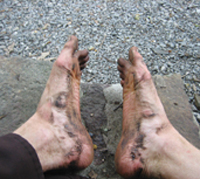 |
| THE FRIARS log 10-15 miles a day—and their feet show it. |
“Is this the end of the road?” we were asked. “It’s really not ‘done done,’” Mark says. “In a way it’s just beginning.”
Travel tips for your journey
That is vocation: trusting in the Lord in every step you take toward him and with him. Our pilgrimage is very similar to the journey of many men and women who are discerning whether God is calling them to the married, single, priesthood, or religious life. This discernment pilgrimage is filled with anxiety, worry, uncertainty, and unease. We don’t know what the future holds, but we must trust the one who holds our future.
Are you willing to make the first step forward on your pilgrimage? Are you willing to carry nothing for the journey except trust in the Lord?
If so, be ready to experience God in new and fantastic ways. Let God’s boundless love and generosity surprise you so much that it becomes no longer a surprise but simple thanksgiving and praise. You don’t need to walk 300 miles with nothing on your back to trust the Lord. You must simply give conversion a place to grow, outside of the safety, security, and comforts of your daily life, and be open to the radiant rays of the gospel. Godspeed.
| THE FRIARS reach their destination: the Franciscan Monastery of the Holy Land in America, Washington, D.C. |
Tags
Related
- Religious making a difference
- Religious seekers in legal limbo
- Mercy meets at the border
- Religious life: The call continues
- Vocation Basics: Essentials for the vocation journey
- Community life: A place to call home
- A charism encourages a caring ministry
- The four main types of religious life
- Our newest religious possess an age-old Christian virtue: hope
- Celibacy steeped in a whole lot of love Read More
Most Viewed
- Find your spirituality type quiz
- FAQs: Frequently asked questions about vocations
- Celibacy quiz: Can you live a celibate life?
- Resources for older discerners or those with physical and developmental differences
- About Vocation Network and VISION Guide


